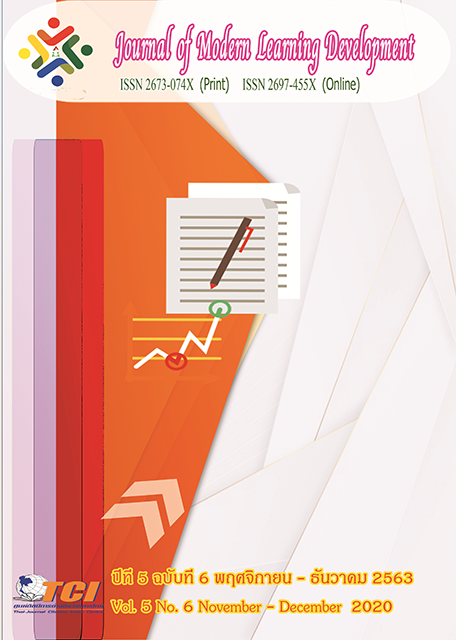Language Styles in Folk Literary of Isan, Klonlam
Main Article Content
Abstract
This thesis aims to analyze language styles presentation and analysis of linguistic features in the creation of folk literatury of Isan, klonlam. In terms of the data used for this study, there are 6 sets of Isan literary books, 23 stories. This Thesis is Documentary Research by the researcher who applied the conceptual framework of Martin Jose's literary style and applied the conceptual framework of aesthetics in words and texts of Duangmon Jitchamnong and Jitrada Suwattikul is the conceptual framework used in the research to analyse and synthetic in Descriptive Analysis.
The results of the research of Language Styles in Fork Literary Of Isan, Klonlam were found that The frozen style are found in the poems of the Fork Literary of Isan Klonlam 14 stories. But The Fomal style, consultative style, casual style and intimate style Will be found in every story that has been analyzed in Language Styles in Fork Literary Of Isan, Klonlam. But Language Styles in Aesthetics in terms of words according to the conceptual framework included 6 issues: 1) rhyme style, i.e. sound, rhyme, both consonants and vowels, 2) Reduplication style, 3) repeating style, 4) dialect style, 5) different words style and 6) other styles, which give the reader a variety of styles in the thoughts of word and sound form. In the texts style was found that The author used 3 styles to using language aimed to creating beauty in figure of speech, namely; metaphors, hyperbole, Onomatopoeia, Personification, and other figure of speechs. In the feeling of Thai literature, it was found that there were all feelings.
Article Details
References
กาญจนา ปราบปัญจะ. (2553). การศึกษาลีลาการใชภาษาและกลวิธีการเขียนของ ว.วชิรเมธี. วิทยานิพนธ์ศิลปศาสตรมหาบัณฑิต สาขาวิชาภาษาไทย. บัณฑิตวิทยาลัย: มหาวิทยาลัยศรีนครินทรวิโรฒ.
กอบกุล อิงคนนท์. (2546). ศัพท์วรรณกรรม. กรุงเทพมหานคร : สำนักพิมพ์ษรฉัตร.
ขวัญใจ บุญคุ้ม. (2559). วัจนลีลาและบทบาทหน้าที่ของเพลงลูกทุ่ง. วิทยานิพนธ์ศิลปศาสตรมหาบัณฑิต สาขาวิชาภาษาไทย. บัณฑิตวิทยาลัย: มหาวิทยาลัยราชภัฏเชียงใหม่.
จารุวรรณ ธรรมวัตร. (2543). ภูมิปัญญาอีสาน. (พิมพ์ครั้งที่ 3). มหาสารคาม : โครงการตำราคณะมนุษยศาสตร์และสังคมศาสตร์ มหาวิทยาลัยมหาสารคาม.
จิตรลดา สุวัตถิกุล. (2538). วรรณคดีวิจารณ์แนวสุนทรียศาสตร์. เอกสารการสอนชุดวิชา ภาษาไทย 7 วรรณคดีวิจารณ์สำหรับครู. 17 มีนาคม 2538. มหาวิทยาลัยสุโขทัยธรรมาธิราช. นนทบุรี : มหาวิทยาลัยสุโขทัยธรรมาธิราช.
ดวงมน จิตร์จำนงค์. (2541). สุนทรียภาพในภาษาไทย. (พิมพ์ครั้งที่ 3). กรุงเทพมหานคร : ศยาม.
ไพบูลย์ แพงเงิน. (2534). กลอนลําภูมิปัญญาของอีสาน. กรุงเทพมหานคร : โอเดียนสโตร์.
รังสรรค์ จันต๊ะ. (2541). การใช้วัจนลีลาและธัมมวัจนโวหารล้านนาของพระสงฆ์ภาคเหนือ. ในรายงานการวิจัย. มหาวิทยาลัยแม่โจ้.
ราชบัณฑิตยสถาน. (2556). พจนานุกรม ฉบับราชบัณฑิตยสถาน พ.ศ. 2554. (พิมพ์ครั้งที่ 2). กรุงเทพมหานคร : นามมีบุ๊คส์พับลิเคชั่นส์ จำกัด.
สมเกียรติ รักษ์มณี. (2551). ภาษาวรรณศิลป์. (พิมพ์ครั้งที่ 3). กรุงเทพมหานคร : สายน้ำใจ.
Joos, Martin (1961). The Five Clocks: a Linguistic Excursion into the Five Styles of English Usage. New York: Harcourt, Brace and World.


